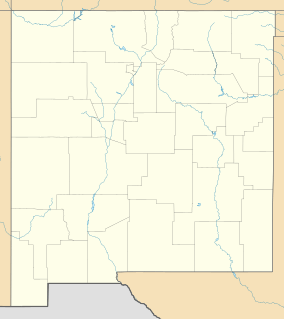Coyote Creek State Park facts for kids
Quick facts for kids Coyote Creek State Park |
|
|---|---|
| Location | Mora, New Mexico, United States |
| Area | 462 acres (187 ha) |
| Elevation | 7,700 ft (2,300 m) |
| Established | 1969 |
| Governing body | New Mexico Energy, Minerals and Natural Resources Department |
Coyote Creek State Park is a special place in New Mexico, USA. It's a state park that protects a beautiful canyon with a stream, nestled in the Sangre de Cristo Mountains. You can find it about 17 miles (27 km) north of a town called Mora. Coyote Creek is famous for having lots of trout, making it a great spot for fishing!
| Top - 0-9 A B C D E F G H I J K L M N O P Q R S T U V W X Y Z |
Exploring Coyote Creek State Park
Where is Coyote Creek State Park?
Coyote Creek is a small stream that flows into the Mora River. It runs south through a valley called Guadalupita Canyon. To the east, a ridge named La Mesa rises to 9,112 feet (2,777 m). To the west are more mountains, part of the Sangre de Cristo range.
The park itself sits in the eastern foothills of these mountains. It is about 7,700 feet (2,300 m) high. The weather here gets about 18 inches (46 cm) of rain or snow each year. The average temperature is 46 °F (8 °C). Summers are usually cool, with temperatures rarely reaching 90 °F (32 °C). Winters, however, can be very cold with lots of snow.
How Coyote Creek Was Formed
The rocks you see at Coyote Creek State Park are very old. They were formed between 320 and 250 million years ago. Back then, this area was covered by a shallow sea. Limestone formed underwater, mixed with sandstone and shale from nearby mountains. The sea came and went many times.
About 70 million years ago, the Sangre de Cristo Mountains began to rise. This pushed the older rocks into a steep tilt. Later, about 8 million years ago, volcanoes erupted to the east. These eruptions created layers of basalt rock. Over time, canyons were carved into these lava flows.
Guadalupita Canyon, where the park is, was carved during the Pleistocene epoch. This was a time when small glaciers were in the mountains. The creek first moved east, following the edge of the basalt. But when it hit softer rocks, it started carving deeper. This created a valley with a steep eastern wall and a gentler slope to the west.
Plants and Animals of the Park
The area right along Coyote Creek is filled with plants like coyote willow. You can also see narrowleaf cottonwood and chokecherry trees. East of the creek, there are wet meadows. Beyond them, you'll find a ponderosa pine forest with Gambel oak growing underneath.
On the west side of the park, there's a forest of different evergreen trees. These include Douglas fir, limber pine, blue spruce, Engelmann spruce, bristlecone pine, and white fir. You'll also find quaking aspen trees, which have leaves that shimmer in the wind. Gambel oak grows beneath these trees too. The park is also known for its beautiful wildflowers, like geraniums, sunflowers, irises, and primroses.
Many animals live in and around the park. You might spot black bears, cougars, elk, mule deer, and red or gray foxes. Other animals include bobcats, coyotes, skunks, and porcupines. Beavers have built small dams along the creek, creating little ponds. These ponds are good for the fish.
The creek is home to different kinds of trout, such as rainbow trout, brown trout, and Rio Grande cutthroat trout. You can also find white suckers. Many types of birds live here too. An endangered bird called the southwestern willow flycatcher even nests and raises its young along Coyote Creek.
History of Coyote Creek State Park
Native Americans lived in the Coyote Creek area for many centuries. However, no major ancient sites have been found inside the park itself. People from Europe and America started settling here in 1837. Three people from Taos received a land grant from the Mexican government. The Coyote Creek valley was farmed, and much of the land was shared by the community.
When New Mexico became part of the United States in 1846, the land grant was almost not recognized. Later, some people started buying up the community lands. To protect their property, the residents of Guadalupita divided up their shared land in 1889.
In the early 1930s, many of these small pieces of land were combined into a large ranch owned by Eusebio Romero. You can still see an old ranch house and the remains of another old building from that time in the park. In the late 1960s, a new owner bought the ranch. About 80 acres (32 ha) of the land was set aside because it was perfect for a state park. The state bought this land on April 24, 1969, for $16,000.
The park works with local landowners to manage the water from an acequia, which is a traditional irrigation ditch system. Coyote Creek State Park became much larger in 2004. The Trust for Public Land bought and donated an additional 382 acres (155 ha) to the park.
Things to Do at Coyote Creek State Park
Coyote Creek State Park is open all year round. Most visitors come to fish, hike, camp, and have picnics. There is a 2-mile (3.2 km) trail that goes around the park. It crosses the creek two times, offering great views of the area.


